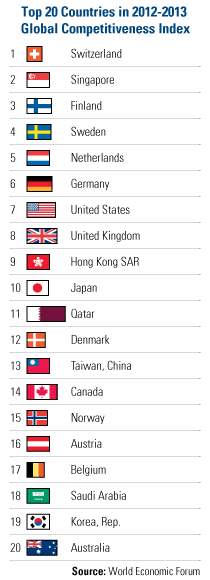The U.S. dropped to No. 7 on the World Economic Forum’s newly released 2012 Global Competitiveness Index report. Switzerland retained its top position as the most competitive nation, followed by Singapore, Finland, Sweden, the Netherlands and Germany.
Asian countries continue to be among the most competitive–and many are gaining strength. Among the top 20, five are from Asia. Compared to last year’s ranking, Singapore retains its No. 2 spot, Hong Kong gained two positions, Taiwan remains No. 13, Korea advanced five spots and Japan dropped one position.

The annual study represents a kind of comprehensive report card for government policymakers, grading their ability to inhibit or foster a competitive and innovative economy. The report ranks countries based on multiple facets: basic necessities such as institutions, infrastructure and the macroeconomic environment; facets that enhance efficiency, including higher education and training, goods market efficiency and technological readiness; and innovation and sophistication.
The factors are ranked separately, but they reinforce each other, as a weakness in one area can negatively affect others. Innovation, for example, is “very difficult to achieve without a healthy, well-educated and trained workforce … adept at absorbing new technologies and without sufficient financing for R&D or an efficient goods market that makes it possible to take new innovations to market,” says the World Economic Forum (WEF).
This is why thoughtfully implemented government policies are vital. As a result of good historical monetary and fiscal actions, the U.S. is “highly sophisticated and innovative” with excellent universities, flexible labor markets, and a large domestic economy that provides opportunity, according to the WEF.
However, leaders in Washington have a bit of work to do to help America regain the top ranking. The report argues that the country’s drawbacks have “deepened since past assessments,” says the report. It points to a business community critical toward public and private institutions, a lack of trust in politicians, and a concern “about the government’s ability to maintain arms-length relationships with the private sector.”
Every country, including the U.S., has its own unique drawbacks (with its own unique set of solutions), but coming up in the rear are emerging markets that have been making solid fiscal and monetary decisions to quickly boost their countries’ competitiveness. For example, Turkey leapt 16 places to rank No. 43.
We’ve discussed how leaders in the Eastern European country have made considerable effort to improve its fiscal and monetary situation. As a result, the country has seen solid economic growth, a stable macroeconomic environment, and improved access to finance for businesses. According to the WEF, Turkey’s businesses have benefitted from a large domestic market, intense local competition, and a “reasonably developed infrastructure.”
The Philippines is another country showing progress as a result of effort by its policymakers, as “it has advanced 22 places since reaching its lowest market in 2009,” says the WEF. The report states that the country has improved its trust in politicians, and corruption and red tape are “finally being addressed decisively,” even though policymakers have more work to do. For example, infrastructure continues to be in a “dire state,” markets remain inefficient and the labor market continues to be rigid.
Although it’ll be a while before we see many emerging markets reach the top 20, savvy investors will keep watch of this annual ranking to make sure they don’t miss out.
Navigate the WEF’s interactive map by clicking here.
All opinions expressed and data provided are subject to change without notice. Some of these opinions may not be appropriate to every investor. By clicking the link above, you will be directed to a third-party website. U.S. Global Investors does not endorse all information supplied by this website and is not responsible for its content.



